|
PREHISTORIC
BEADS
Beads have been defined as attractive and precious
objects, perforated usually through the middle and strung for various purposes.
They were used to express and elaborate personal identity for a large part of
human history. Early dates for the use of beads range somewhere between 33,000
to 45,000 years ago from estimates of an early Later Stone Age stratum in Border
Cave in South Africa. Even Neanderthals are known to have made and used beads.
Most of the ancient beads that were manufactured during prehistoric
times were made of softer materials like sea shell, egg shell, bone, ivory,
teeth, claystone, shale, etc. Even pine nuts, fruit pits and seeds were used as
beads. But some early cultures, also made them out of extremely hard
materials like jade.
Some of the earliest beads may have been worn to represent a social
group rather than the individual. But whatever they were meant to convey in the
beginning they certainly became an individual ornamentation as early as the
Aurignacian period in Europe. What is most striking is the care they took to
create an artistically unique item for adornment. Randy White of New York
University has studied over 18,000 Aurignacian beads. These beads would date to
somewhere between 32,000 and 28,000 years ago. By this time these people were
choosing exotic materials away from their local territory to make their beads.
If they lived in an area where ivory was available they used something from
another area such as sea shells and someone in an area of sea shells might use
ivory to make their beads. The idea was to make them as interesting and unique as
possible.
In North America the earliest beads date to approximately 11,000
years ago within the Folsom culture. Beads were made throughout the
archaeological record in this part of the world. In the southwestern U.S. the
Desert people wore necklaces as their most popular pieces of jewelry, even
before glass trade beads became widely available. In Mexico, bead making reached
its highest skill level within some of the Late Stone Age cultures like the
Aztec. They used many hard stones, the hardest of which was jade. These large
organized societies were able to support craftsman who worked within specialized
trades such as jewelry making.
|
|
POVERTY POINT STONE BEADS
LOWER MISSISSIPPI VALLEY
CHARLES E. MOORE COLL.
Poverty Point is the largest and most complex Late Archaic site in North
America. It was discovered in 1953 by an archaeologist who discovered the peculiar
earthworks on aerial photographs taken by an Army mapmaker. This site is
located in northeastern Louisiana in West Carroll County. It was in use
for over one thousand years dating to between 3800 and 2500 years ago.
These people produced the largest Archaic Period earthworks ever built in
the United States. The house structures on this site were built on a
series of six concentric semicircular embankments each measuring six
feet high, 80 feet across and over 3600 feet long. A large bird effigy
mound measuring 70 feet high and 640 feet across is also located on the
Poverty Point site.
The Poverty Point culture was made up of several large and
small settlement sites located in Louisiana and Mississippi. These people
had a large network of trade relationships that brought in cherts from the
north, steatite from the Appalachians and many other raw materials such as
galena (lead), hematite, sandstone, jasper, slate, etc. The featured
Poverty Point beads in this article were found near the Poverty Point site
in Louisiana but also on sites in Alabama and one in Arkansas. Attesting
to the far flung trade connections that must has been in existence at that
time.
The Poverty Point culture developed a tradition of making
high quality stylized carved and polished miniature stone beads. Other
early cultures in the United States rarely used stone to make their beads
opting for softer materials such as shell or bone. The fine cutting,
engraving and polishing lapidary work these people did that resulted in
such fine and unique art forms is quite remarkable. They were made in the
image of many different animals that would have been common to their
environment at that time. But they also made the more common tubular
beads. The earliest recorded human figurines so far discovered in North
America and made from fired clay were found on the Poverty Point site in Louisiana.
The people who were able to craft such creative artistry as
exhibited in these wonderful sculptures must have lived during a time when
their lives were more at ease, not under high stress as many other
cultures before and after them. A situation that benefits us all to marvel
at what they left behind.
|
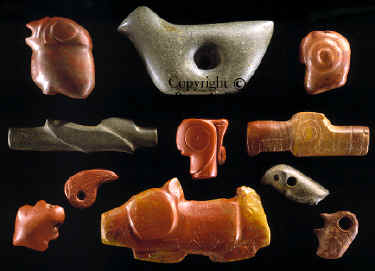
CLICK ON
PICTURE FOR LARGER IMAGE
GROUP OF POVERTY
POINT ANIMAL EFFIGY BEADS
ALABAMA, ARKANSAS & LOUISIANA
CHARLEY
MOORE COLLECTION
These stone beads, carved in highly stylized effigies of animals, were
collected on Poverty Point sites in Alabama, Arkansas and Louisiana.
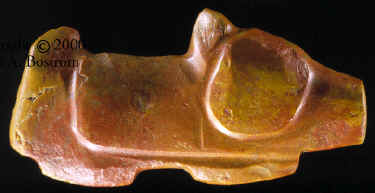
CLICK ON
PICTURE FOR LARGER IMAGE
POVERTY POINT BEAD
DOG
FOUND NEAR
BARTHOLOMEW BAYOU, IN ARKANSAS
CHARLEY
MOORE COLLECTION
This large dog effigy bead is made of orange and yellow jasper. The hole
is drill length wise through the center. This large bead measures 2 5/16
inches long. 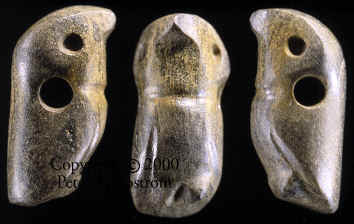
CLICK ON PICTURE FOR LARGER
IMAGE
POVERTY POINT BEAD
OWL
FOUND NEAR THE POVERTY POINT SITE IN LOUISIANA
CHARLEY MOORE COLLECTION
This picture shows three views of a bird with carved feet, wings, eyes and
beak. It may represent an owl. 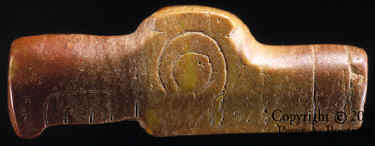
CLICK ON PICTURE FOR
LARGER IMAGE
POVERTY POINT BEAD
VULTURE HEAD
FOUND NEAR SEVEN MILE LAKE IN
LAUDERDALE COUNTY, LOUISIANA
CHARLEY MOORE COLLECTION
This beautifully carved and engraved bead seems to represent the likeness
of a turkey vulture. It's made from red, orange and yellow jasper.

CLICK ON
PICTURE FOR LARGER IMAGE
POVERTY POINT BEAD
LOCUST
LAUDERDALE
COUNTY, ALABAMA
CHARLEY
MOORE COLLECTION
This bead is carved into a highly stylized representation of a locust. The
hole is drilled length wise through the center.
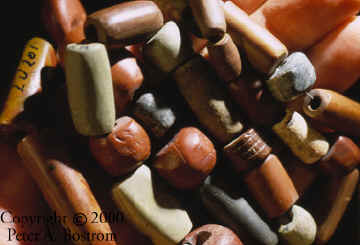
CLICK ON PICTURE FOR
LARGER IMAGE
HANDFUL OF
POVERTY POINT TUBE BEADS
SOUTHEASTERN
UNITED STATES
CHARLES
MOORE COLLECTION
This picture shows a large variety of different shapes of tubular stone
beads from the Poverty Point culture in southern United States. The
brighter colored red, orange and yellow examples are made of jasper.
|
|
MORE
BEADS

ONE EFFIGY & THREE PLAIN STONE
BEADS
CAHOKIA MOUNDS HISTORIC SITE
MADISON AND ST. CLAIR COUNTIES IN ILLINOIS
APPROXIMATELY 1100 YEARS AGO
HARRY JOHNSON COLLECTION
These four stone beads were
found several years ago on the Cahokia Mounds site. At least two of
these beautiful beads are made of crystal. The one on the left is a
carving of an owls head. The other three are plain round and drilled
beads. What is remarkable is the difficulty the crystal would present
the maker to drill, cut and polish such a hard material. 
HOPEWELL FRESH WATER PEARL BEADS
OGDEN-FETTIE MOUND GROUP AND
VILLAGE SITE
FULTON COUNTY, ILLINOIS
The artifacts in this picture
are all Hopewell related. The clay figurine is from the Carrier Mills
site in southern Illinois. Of particular interest in this picture are
the fresh water pearl beads. They were gathered sometime around 2,000
years ago in the waterways along and near the Illinois River. These are
some of the most exotic and rare beads to have survived in Illinois from
prehistoric times.
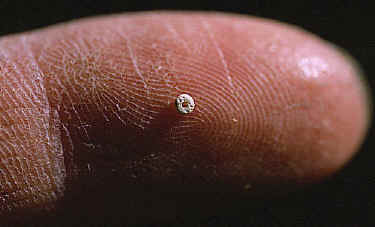
FOLSOM BEAD
SHIFTING SAND
SITE---TEXAS
11,000 YEARS AGO
DEPT. OF
ANTHROPOLOGY-- UNIVERSITY OF KANSAS COLL.
This stone tiny
bone or ivory bead was found stuck to a stone flake during excavation of
the Shifting Sand site in Texas. It represents one of the oldest beads
ever found in the united States.
|
|
"REFERENCES"
1999,
"Central States Archaeological Journal", Vol. 46 Number 1, PP
20-22.
1996, "The Oxford Companion to Archaeology", pp 481-482.
1995, "The Neandertal Enigma", pp 320-321.
1989, "Hammond Ambassador World Atlas", pp 238-239.
1988, "Encyclopedia of Human Evolution and Prehistory", pp
290-291.
1983, "America's Ancient Treasures", 232-234.
1979, "Webster's New Twentieth Century Dictionary", pp 1021.
1978, "Jewelry of the Prehistoric Southwest", pp ix & 20.
1912, "Handbook of American Indians North of Mexico--Vol. I", pp
137.
|